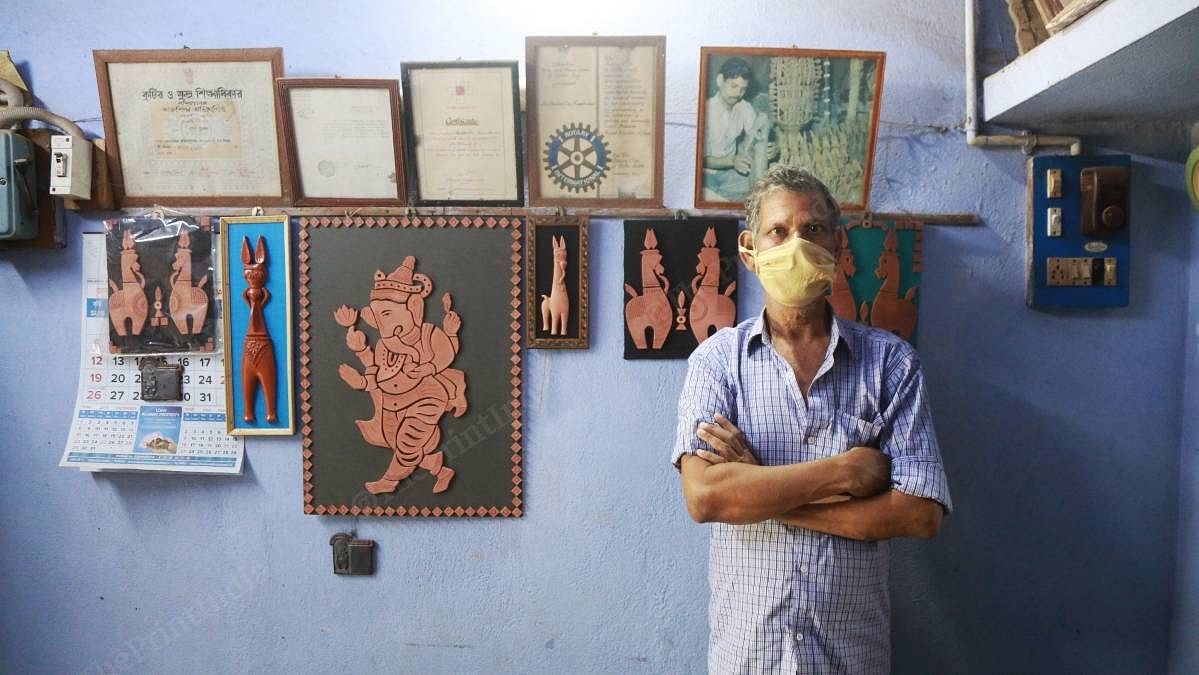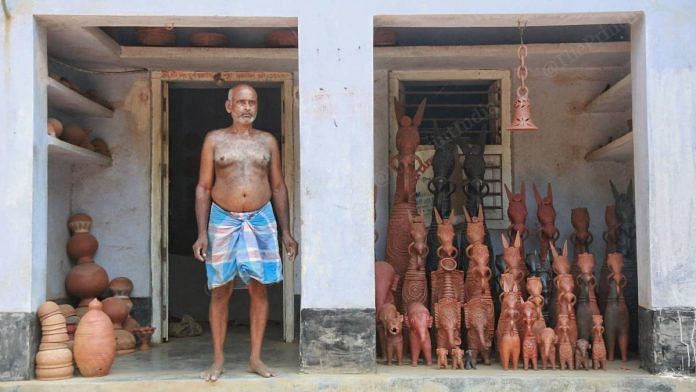Taldangra, Bankura: The scourge of the coronavirus has all but halted the march of an ancient art form practised exclusively in a small village in West Bengal.
The kumbhakars or potters in the Panchmura village of Bishnupur in Bankura district are less than a hundred families today. These men and women have carried on their robust shoulders the 1,000-year heritage of making terracotta products — mainly horse figurines or tiles made of baked earth.
But the virus has played havoc with the livelihood in this village, which is a 40 kilometre-ride from Bankura town through a forested stretch.
The crackling sound of slow-roasted or fired clay is silent today as products have become hard to sell.
The virus has not only killed artisans, but is also killing the art, said potters in this village of Dalits. As many as 287 villagers, both men and women, from 88 families were engaged in this profession.

Unable to adapt to online marketing due to lack of resources, villagers here desperately sought help from governments to allay the doom. They did not wish to abandon their art and migrate to cities, potters said, adding, they would rather work as local domestic help.
Government authorities, though, wanted artisans to go online to sell their wares. Potters said that was impossible given the lack of many things — Internet availability, for one.
Also read: ‘Survived Covid, but dying businesses will kill us’: Bengal kantha artists are now labourers
History of terracotta
Terracotta or burnt or baked soil is a tradition that traces its roots to the 8th century. It started from Panchmura village in Bishnupur under the Malla dynasty.
Due to the short supply of stones in Bengal, burnt clay bricks became a substitute and the unique craft of ‘terracotta’ was born.
The art reached its peak in the 17th century. Raja Jagat Malla and his descendants built numerous temples with intricate terracotta murals and carvings sculpted on their walls.
Over a period of time, the long-necked Bishnupur horse became the abiding form of terracotta art. It has become a popular symbol of rural handicraft’s artistic excellence.
Cry of help from artisans
Before the pandemic, a potter-artist earned nearly Rs 10,000 per month after meeting all expenses, potters said.
They did not sell products directly to the market but to whole-sellers and construction material suppliers (for the tiles). These agents came to the village to source their work, but rarely visit now.
The signature item produced in this village, apart from tiles, is the long-necked horse, known famously as the Bishnupur horse. Artisans sell a small one here for Rs 150-200, which go for a significantly higher price in retail outlets and boutiques in cities.
Bhootnath Kumbhakar, the secretary of the potters’ association, has written letters to both the central and state governments to inoculate artists and revive the sinking art form. While he is yet to get a response on supporting the art form, the district administration has vaccinated the 287 artisans from the village.
He told ThePrint: “Our work — mostly horses and tiles for interior decoration — have no takers today. We have done this for decades and know no other profession.” Kumbhakar added farming was not an option because the region is infertile. Covid has also ruined his plans to make the next generation “innovate and modernise the art form”.
The walls of 70-year-old Buddhadeb Kumbhakar’s dilapidated house speak of a glorious past.
Old photographs from his visits to Russia and Germany, numerous award functions and certificates look forlorn on the dry, clay walls. “But they do not fetch me money to feed my family of eight,” Buddhadeb said.

Terracotta is in their genes, the potter said, adding, “Nobody taught us to make clay models or idols. We learnt it on our own. It is a delicate art and it demands huge labour. The pandemic claimed some of our artists, and now it is killing the art.”
Bemoaning the lack of government help, Buddhadeb said villagers had to travel 25 kilometres for a “basic health check-up”.
Another artist, Narayan Kumbhakar, is worse off. Two of his family members were down with Covid last month. One of them got tested in a local primary health centre but was given the report after 10 days.
“My elder brother had fever and a dry cough. He cycled to the nearby health centre and got tested. But the report came after 10 days. He was not in isolation and in the process infected another family member. Both recovered in a few days, but why should a report take 10 days?” Narayan asked.
Narayan said it was also quite a task to persuade the district administration to vaccinate them. “We wrote many letters for vaccination to happen. But we are yet to get any assistance to make ends meet. We can barely arrange two meals. We have no money in hand,” he said.
Also read: No net, no school, so this 12-yr-old boy spends his time re-crafting 1,000-yr-old Bengal art
Government help, or the problem with it
A senior official of Bankura said the administration was “trying to procure some of their artworks to provide financial relief to the artisans”.
Local MLA Arup Chakraborty said artisans “must try to create an online market for the terracotta work”.
He added: “We have asked local panchayats to help build an online marketplace or register with e-commerce portals to sell these products.” Lockdown has impacted business, he said.
He also said artisans who come from the scheduled caste communities were eligible for the chief minister’s monthly allowance scheme of Rs 1,000 per family. The administration was also trying to streamline the ration delivery to their homes, an official said.
Villagers, however, are flummoxed at the very prospect of going online. Consider poor Internet penetration, problems of packaging and transportation, they said.
Bhoothnath Kumbhakar said: “We do not have the resources to supply directly to e-commerce platforms. These are very delicate products and need specialised packaging. We don’t have basic amenities here. How would we even expect seamless Internet service and transportation from this interior place? We have requested Grameen Khadi, both state and central departments, to help us.”
Also read: Why West Bengal’s Covid infection rate is at 1.36, much higher than India’s 0.78



